Danish actor, director, scriptwriter, and producer Viggo Larsen (1880-1957) was one of the pioneers of Danish cinema. With Wanda Treumann he later directed and produced many German films during the 1910s.
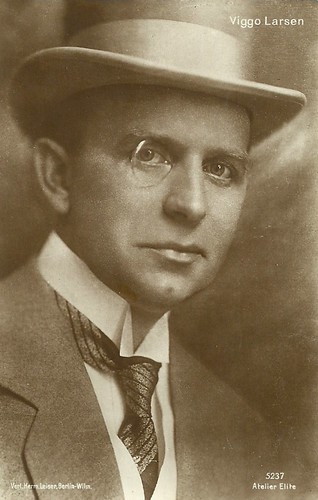
German postcard by Verlag Hermann Leiser, Berlin-Wilm., no. 5237. Photo: Atelier Elite.

German postcard by Rotophot in the Film-Sterne series, no. 84/2. Photo: Messter Film/Karl Schenker, Berlin.
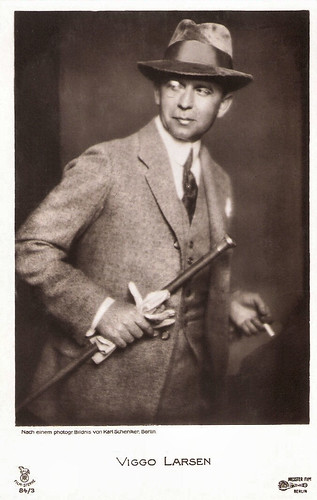
German postcard by Rotophot in the Film-Sterne series, no. 84/3. Photo: Messter-Film / Karl Schenker, Berlin.

German postcard by Rotophot in the Film Sterne series, no. 84/6. Photo: Karl Schenker.
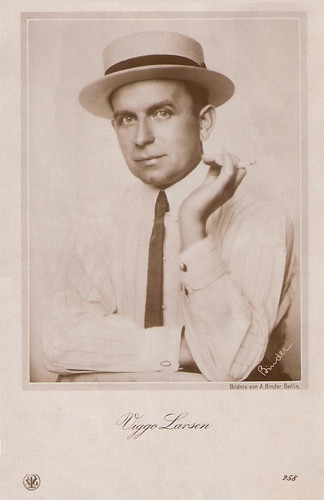
German postcard by NPG, no. 258. Photo: Alex Binder.
Born in Copenhagen in 1880, Viggo Larsen was first military trained.
Then he started to work in a cinema that was part of Ole Olsen’s cinema chain. After the founding of the Nordisk Film Kompagni (Nordisk film company) by Olsen in 1906, Viggo Larsen joined him. He started a career as a film actor, scriptwriter, and director, one of the first in Denmark.
Between 1906 and 1909 Larsen shot some 29 films in Denmark, among which the more well-known are Løvejagten/Lion Hunt (Viggo Larsen, 1907) and the Sherlock Holmes film Den Graa dame/The Grey Dame (Viggo Larsen, 1909).
In his ten-minute short Løvejagten/Lion Hunt (1907) two big game hunters (Viggo Larsen and Knud Lumbye) are on safari in the jungle with their African guide. They observe zebras, ostrich, and a hippopotamus, and catch a small monkey for a pet. During the night they are awakened by a lion that kills a small goat and then the hunters' horse. The hunters shoot the lion as it stands by the water on a beach. They discover another lion and shoot it also. The lions are gutted and skinned. The happy hunters sit and smoke cigarettes afterward.
Larsen had filmed the lion hunt at the little Danish island of Elleore in the Roskilde fjord (decorated with palm fronds and artificial plants to simulate a tropical savanna) and in the Copenhagen Zoo. The actual shooting of two captive lions, Larsen had bought from the Hagenbeck Zoo in Hamburg, caused an enormous public protest in Denmark and the film was banned. However, the hitherto unusual and attractive use of exotic animals and the publicity from the protests created success in Sweden.
The following year, after the charges of animal cruelty, were dropped and the Danish ban was rescinded, the film had its premiere in Denmark. Nordisk eventually sold 259 prints of Løvejagten, which earned the company an enormous profit. It ushered in the 'golden age' of Danish cinema when Nordisk Film became the most productive film company in Europe. A sequel to the film, Bear Hunting in Russia, was shot in 1909 and was also a profitable film, eventually selling 118 prints.
According to IMDb reviewer kekseksa, it was all a set-up: "Ole Olsen was really a bit of a rascal by any standards and this whole film was something of a carefully-conceived publicity stunt for the newly-founded Nordisk Company. And it worked a dream. The word got around about the film; the Danish Society for the Prevention of Cruelty to Animals complained to the authorities who banned the making of the film. Olsen ignored them and went ahead. The film was banned when it came out but Olsen just slipped it across the border and premiered it in Sweden. And, as a direct result of all these shenanigans, the film was a huge international success and did indeed set Nordisk on its dizzy path to glory."
The Sherlock Holmes film Den Graa dame/The Grey Dame (Viggo Larsen, 1909) was another box office hit that fascinated audiences. Larsen played Holmes and Holger-Madsen Doctor Watson. The film was based on The Hound of the Baskervilles, but the dog was replaced by a ghost in this adaptation. The film thrilled the audience thanks to Holmes' excursions through creepy alleys, and the highlight was the appearance of the ghost, the grey dame.
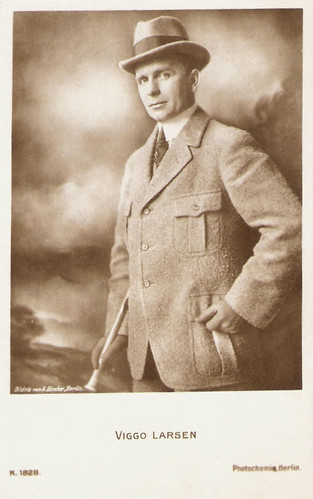
German postcard by Photochemie, no. K.1828. Photo: A. Binder, Berlin.
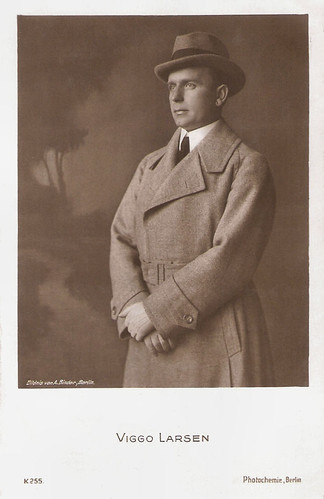
German postcard by Photochemie, no. K. 255. Photo: A. Binder, Berlin.

German postcard by Photochemie, no. K.256. Photo: A. Binder, Berlin.
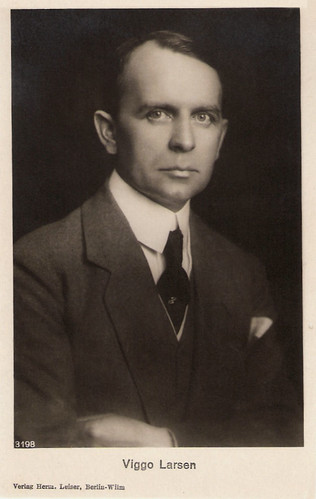
German postcard by Verlag Herm. Leiser, Berlin-Wilm., no. 3198.
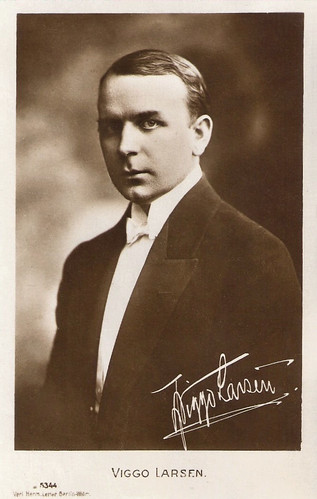
German postcard by Verlag Herm. Leiser, Berlin, no. 5344.
In 1910 Viggo Larsen left Denmark and continued his career in Berlin, Germany, at the company Vitascope. Because of the previous success of his Sherlock Holmes films, he produced and directed various films inspired by the British detective. An example is the film serial Arsène Lupin gegen Sherlock Holmes/Arsène Lupin contra Sherlock Holmes (Viggo Larsen, 1910) with Paul Otto as Arsène Lupin and Larsen himself as Holmes. In 1918, he played Sherlock Holmes for the last time.
In 1910 Larsen discovered the stage actress Wanda Treumann at the Berliner Lustspielhaus. He would shoot many films with her and together they founded in 1912 the production company Treumann Larsen Film GmbH.
Larsen also did a rip-off of the popular White Slave films by Nordisk entitled Der weisse Sklavin, 3.Teil/The White Slave, Part 3 (Viggo Larsen, 1911) with Wanda Treumann and Max Mack. The film hinted at the previous two films by Nordisk, about which Ole Olsen probably was not amused.
One typical example is the film Die Sumpfblume/The marsh flower (Viggo Larsen, 1913), in which Traumann is a Vaudeville actress whose foot is copied in stone by a sculptor. She goes up the social ladder and marries a rich aristocrat (Larsen). He is appalled when he finds the sculpture and thus finds out about her past, so he strangles her.
Another fine example that survived is Wanda’s Trick (1917), in which a cigarette factory girl (Traumann) offers herself as first prize in a lottery in order to save the factory from ruin. Larsen only did the production of this film, while Franz Eckstein directed it.
He also made a German silent Western, Frank Hansens Glück/Frank Hansen's Fortune (Viggo Larsen, 1917). Larsen and Lupu Pick played two diggers working in the Mexican diamond fields, who discover a very valuable diamond. It leads to a series of events that sees only one of them become rich.
After a highly productive career, Viggo Larsen quit directing in 1921 and focused on acting. Larsen’s last film was the biopic Diesel (Gerhard Lamprecht, 1942) starring Willy Birgel as Rudolf Diesel the German inventor of the diesel engine. It was one of a series of prestigious biopics made in Nazi Germany portraying genius inventors or artists struggling against the societies in which they live.
Viggo Larsen stayed in Germany until the end of the Second World War and returned to Denmark in 1945. He died in Copenhagen in 1957 at the age of 76. He had appeared in 140 films between 1906 and 1942 and had directed 235 films between 1906 and 1921.
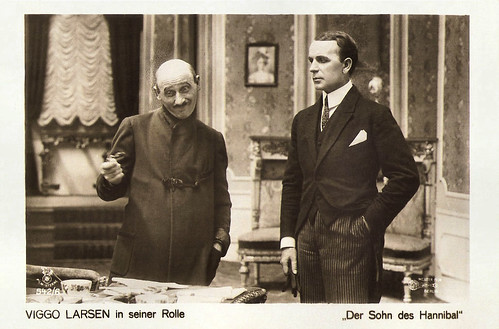
German postcard by Rotophot in the Film Sterne series, no. 542/6. Photo: Messter-Film. Publicity still for Der Sohn des Hannibal/The Son of Hannibal (Viggo Larsen, 1918).

German postcard by Rotophot in the Film-Sterne series, no. 562/1. Photo: Messter-Film, Berlin. Viggo Larsen in Der Mann mit den sieben Masken/The Man with the Seven Masks (Viggo Larsen, 1918-1919), an adaptation of the novel by Erich (von) Wulffen, about an impostor who is followed by a woman.

German postcard by Rotophot in the Film-Sterne series, no. 562/3. Photo: Messter-Film, Berlin. Viggo Larsen in Der Mann mit den sieben Masken/The Man with the Seven Masks (Viggo Larsen, 1918).
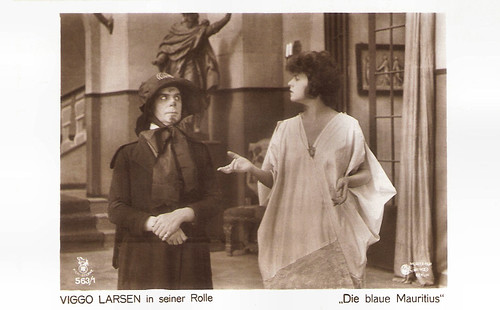
German postcard by Rotophot in the Film Sterne series, no. 563/1. Photo: Mester-Film, Berlin, Berlin. Viggo Larsen and Ria Jende in Die Blaue Mauritius/The Blue Mauritius (Viggo Larsen, 1918).

German postcard in the Film-Sterne series by Rotophot, no. 563/4. Photo: Messter-Film, Berlin. Viggo Larsen in Die blaue Mauritius/The Blue Mauritius (Viggo Larsen, 1918).
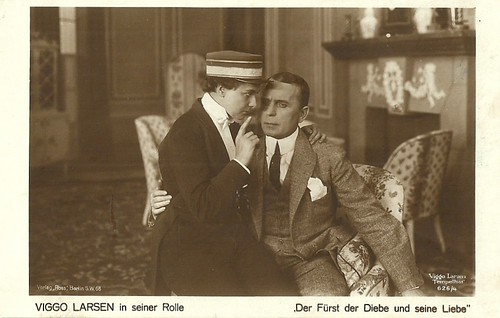
German postcard by Ross Verlag, no. 626/4. Photo: Viggo Larsen Tempelhof. Viggo Larsen in Der Fürst der Diebe und seine Liebe/The King of Thieves and His Love (Viggo Larsen, 1919).

German postcard by Verlag Ross, no. 626/5. Photo: Viggo Larsen, Tempelhof. Viggo Larsen and Erra Brognar in Der Fürst der Diebe und seine Liebe/The King of Thieves and His Love (Viggo Larsen, 1919).
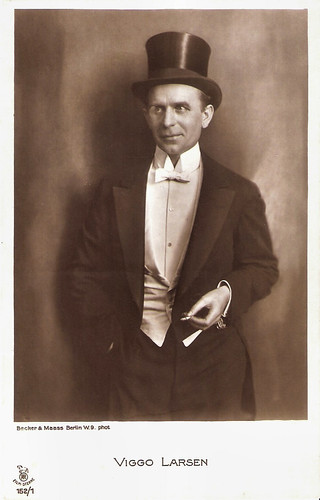
German postcard by Rotophot in the Film Sterne series, no. 152/1. Photo: Becker & Maass, Berlin.

German postcard by Rotophot in the Film-Sterne series, no. 152/4. Photo: Becker & Maass, Berlin.

German collectors card by Ross Verlag in the series Vom Werden Deutscher Filmkunst - Der Stumme Film, picture, no, 16, Group 43. Photo: Karl Schenker.
Sources: Wikipedia (German and English) and IMDb.
This post was last updated on 11 April 2021.

German postcard by Verlag Hermann Leiser, Berlin-Wilm., no. 5237. Photo: Atelier Elite.

German postcard by Rotophot in the Film-Sterne series, no. 84/2. Photo: Messter Film/Karl Schenker, Berlin.

German postcard by Rotophot in the Film-Sterne series, no. 84/3. Photo: Messter-Film / Karl Schenker, Berlin.

German postcard by Rotophot in the Film Sterne series, no. 84/6. Photo: Karl Schenker.

German postcard by NPG, no. 258. Photo: Alex Binder.
Sherlock Holmes
Born in Copenhagen in 1880, Viggo Larsen was first military trained.
Then he started to work in a cinema that was part of Ole Olsen’s cinema chain. After the founding of the Nordisk Film Kompagni (Nordisk film company) by Olsen in 1906, Viggo Larsen joined him. He started a career as a film actor, scriptwriter, and director, one of the first in Denmark.
Between 1906 and 1909 Larsen shot some 29 films in Denmark, among which the more well-known are Løvejagten/Lion Hunt (Viggo Larsen, 1907) and the Sherlock Holmes film Den Graa dame/The Grey Dame (Viggo Larsen, 1909).
In his ten-minute short Løvejagten/Lion Hunt (1907) two big game hunters (Viggo Larsen and Knud Lumbye) are on safari in the jungle with their African guide. They observe zebras, ostrich, and a hippopotamus, and catch a small monkey for a pet. During the night they are awakened by a lion that kills a small goat and then the hunters' horse. The hunters shoot the lion as it stands by the water on a beach. They discover another lion and shoot it also. The lions are gutted and skinned. The happy hunters sit and smoke cigarettes afterward.
Larsen had filmed the lion hunt at the little Danish island of Elleore in the Roskilde fjord (decorated with palm fronds and artificial plants to simulate a tropical savanna) and in the Copenhagen Zoo. The actual shooting of two captive lions, Larsen had bought from the Hagenbeck Zoo in Hamburg, caused an enormous public protest in Denmark and the film was banned. However, the hitherto unusual and attractive use of exotic animals and the publicity from the protests created success in Sweden.
The following year, after the charges of animal cruelty, were dropped and the Danish ban was rescinded, the film had its premiere in Denmark. Nordisk eventually sold 259 prints of Løvejagten, which earned the company an enormous profit. It ushered in the 'golden age' of Danish cinema when Nordisk Film became the most productive film company in Europe. A sequel to the film, Bear Hunting in Russia, was shot in 1909 and was also a profitable film, eventually selling 118 prints.
According to IMDb reviewer kekseksa, it was all a set-up: "Ole Olsen was really a bit of a rascal by any standards and this whole film was something of a carefully-conceived publicity stunt for the newly-founded Nordisk Company. And it worked a dream. The word got around about the film; the Danish Society for the Prevention of Cruelty to Animals complained to the authorities who banned the making of the film. Olsen ignored them and went ahead. The film was banned when it came out but Olsen just slipped it across the border and premiered it in Sweden. And, as a direct result of all these shenanigans, the film was a huge international success and did indeed set Nordisk on its dizzy path to glory."
The Sherlock Holmes film Den Graa dame/The Grey Dame (Viggo Larsen, 1909) was another box office hit that fascinated audiences. Larsen played Holmes and Holger-Madsen Doctor Watson. The film was based on The Hound of the Baskervilles, but the dog was replaced by a ghost in this adaptation. The film thrilled the audience thanks to Holmes' excursions through creepy alleys, and the highlight was the appearance of the ghost, the grey dame.

German postcard by Photochemie, no. K.1828. Photo: A. Binder, Berlin.

German postcard by Photochemie, no. K. 255. Photo: A. Binder, Berlin.

German postcard by Photochemie, no. K.256. Photo: A. Binder, Berlin.

German postcard by Verlag Herm. Leiser, Berlin-Wilm., no. 3198.

German postcard by Verlag Herm. Leiser, Berlin, no. 5344.
White slave
In 1910 Viggo Larsen left Denmark and continued his career in Berlin, Germany, at the company Vitascope. Because of the previous success of his Sherlock Holmes films, he produced and directed various films inspired by the British detective. An example is the film serial Arsène Lupin gegen Sherlock Holmes/Arsène Lupin contra Sherlock Holmes (Viggo Larsen, 1910) with Paul Otto as Arsène Lupin and Larsen himself as Holmes. In 1918, he played Sherlock Holmes for the last time.
In 1910 Larsen discovered the stage actress Wanda Treumann at the Berliner Lustspielhaus. He would shoot many films with her and together they founded in 1912 the production company Treumann Larsen Film GmbH.
Larsen also did a rip-off of the popular White Slave films by Nordisk entitled Der weisse Sklavin, 3.Teil/The White Slave, Part 3 (Viggo Larsen, 1911) with Wanda Treumann and Max Mack. The film hinted at the previous two films by Nordisk, about which Ole Olsen probably was not amused.
One typical example is the film Die Sumpfblume/The marsh flower (Viggo Larsen, 1913), in which Traumann is a Vaudeville actress whose foot is copied in stone by a sculptor. She goes up the social ladder and marries a rich aristocrat (Larsen). He is appalled when he finds the sculpture and thus finds out about her past, so he strangles her.
Another fine example that survived is Wanda’s Trick (1917), in which a cigarette factory girl (Traumann) offers herself as first prize in a lottery in order to save the factory from ruin. Larsen only did the production of this film, while Franz Eckstein directed it.
He also made a German silent Western, Frank Hansens Glück/Frank Hansen's Fortune (Viggo Larsen, 1917). Larsen and Lupu Pick played two diggers working in the Mexican diamond fields, who discover a very valuable diamond. It leads to a series of events that sees only one of them become rich.
After a highly productive career, Viggo Larsen quit directing in 1921 and focused on acting. Larsen’s last film was the biopic Diesel (Gerhard Lamprecht, 1942) starring Willy Birgel as Rudolf Diesel the German inventor of the diesel engine. It was one of a series of prestigious biopics made in Nazi Germany portraying genius inventors or artists struggling against the societies in which they live.
Viggo Larsen stayed in Germany until the end of the Second World War and returned to Denmark in 1945. He died in Copenhagen in 1957 at the age of 76. He had appeared in 140 films between 1906 and 1942 and had directed 235 films between 1906 and 1921.

German postcard by Rotophot in the Film Sterne series, no. 542/6. Photo: Messter-Film. Publicity still for Der Sohn des Hannibal/The Son of Hannibal (Viggo Larsen, 1918).

German postcard by Rotophot in the Film-Sterne series, no. 562/1. Photo: Messter-Film, Berlin. Viggo Larsen in Der Mann mit den sieben Masken/The Man with the Seven Masks (Viggo Larsen, 1918-1919), an adaptation of the novel by Erich (von) Wulffen, about an impostor who is followed by a woman.

German postcard by Rotophot in the Film-Sterne series, no. 562/3. Photo: Messter-Film, Berlin. Viggo Larsen in Der Mann mit den sieben Masken/The Man with the Seven Masks (Viggo Larsen, 1918).

German postcard by Rotophot in the Film Sterne series, no. 563/1. Photo: Mester-Film, Berlin, Berlin. Viggo Larsen and Ria Jende in Die Blaue Mauritius/The Blue Mauritius (Viggo Larsen, 1918).

German postcard in the Film-Sterne series by Rotophot, no. 563/4. Photo: Messter-Film, Berlin. Viggo Larsen in Die blaue Mauritius/The Blue Mauritius (Viggo Larsen, 1918).

German postcard by Ross Verlag, no. 626/4. Photo: Viggo Larsen Tempelhof. Viggo Larsen in Der Fürst der Diebe und seine Liebe/The King of Thieves and His Love (Viggo Larsen, 1919).

German postcard by Verlag Ross, no. 626/5. Photo: Viggo Larsen, Tempelhof. Viggo Larsen and Erra Brognar in Der Fürst der Diebe und seine Liebe/The King of Thieves and His Love (Viggo Larsen, 1919).

German postcard by Rotophot in the Film Sterne series, no. 152/1. Photo: Becker & Maass, Berlin.

German postcard by Rotophot in the Film-Sterne series, no. 152/4. Photo: Becker & Maass, Berlin.

German collectors card by Ross Verlag in the series Vom Werden Deutscher Filmkunst - Der Stumme Film, picture, no, 16, Group 43. Photo: Karl Schenker.
Sources: Wikipedia (German and English) and IMDb.
This post was last updated on 11 April 2021.
No comments:
Post a Comment